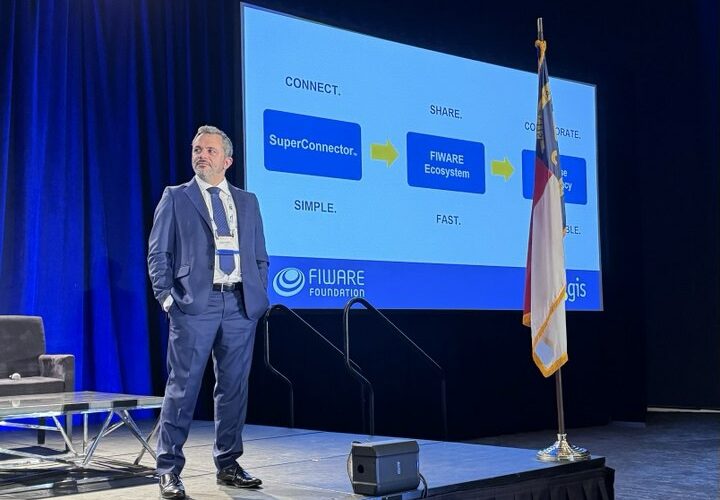Attending the Smart Cities Connect Conference and Expo, held from May 7–10, 2024, in vibrant Raleigh, NC, was an illuminating experience. This premier event brought together innovators, policymakers, and solution providers to discuss the challenges and opportunities in advancing smart city initiatives. From innovative urban planning strategies to the latest in technology adoption, the conference served as a nexus for exploring how smart cities can leverage technology to create better, more sustainable urban environments.
One topic that stood out was the transformative role of open standards and software in the consumption and deployment of smart city solutions across the United States. The conversations highlighted not only the current state of the market but also a fascinating comparison between the American and European approaches to smart city implementation.
The Role of Open Standards and Software in U.S. Smart City Development
The adoption of open standards and software has proven to be a cornerstone in facilitating interoperability and scalability in smart city projects. Open standards ensure that various systems—traffic management, energy grids, water networks, and public safety infrastructures—can communicate seamlessly. This reduces vendor lock-in, enhances flexibility, and allows cities to adopt the best tools from multiple providers.
At the conference, several speakers underscored how open-source platforms and software tools are enabling American municipalities to deploy innovative solutions at a lower cost. For example:
- Real-time data sharing platforms based on open standards are helping cities make evidence-based decisions.
- Flexible integration models are enabling smaller cities with limited budgets to participate in larger smart city ecosystems.
The conversations revealed how open standards act as an enabler of innovation, encouraging new players to enter the market while driving down costs for municipalities. This approach also fosters collaboration, as cities share best practices and build upon existing frameworks rather than starting from scratch.
Comparing the American and European Markets
A recurring theme at the conference was the contrast between the U.S. and European smart city markets. While both regions aim to modernize urban infrastructures, their approaches diverge in several key ways:
Regulatory Frameworks
- Europe: European Union countries benefit from centralized regulations and funding mechanisms that promote alignment across member states. Initiatives like the European Green Deal and standards developed by organizations such as ETSI (European Telecommunications Standards Institute) help create a unified approach.
- United States: In contrast, the U.S. smart city market is more fragmented, with municipalities and states often pursuing independent projects. While this enables localized innovation, it also results in variability and challenges in achieving nationwide scalability.
Focus Areas
- Europe: European cities tend to prioritize environmental sustainability and citizen engagement. For instance, many European projects focus on energy efficiency and the circular economy.
- United States: U.S. cities are placing a greater emphasis on public safety, mobility, and economic growth, with projects often driven by public-private partnerships.
Software Adoption
European markets often adopt stricter requirements for privacy and data security due to the General Data Protection Regulation (GDPR), which influences the design of software solutions. In contrast, the U.S. market is seeing faster experimentation in areas like AI-driven surveillance and predictive analytics, albeit with fewer privacy regulations.
The Need for ETSI and NIST Collaboration
A key takeaway from the event was the recognition that organizations like ETSI and NIST (National Institute of Standards and Technology) must align and cooperate to create global frameworks for smart city development. These entities are instrumental in setting standards for interoperability, data security, and communication protocols.
- ETSI: As a leader in developing technical standards in Europe, ETSI focuses on ensuring seamless communication in technologies like IoT, 5G, and edge computing.
- NIST: NIST plays a similar role in the U.S., focusing on advancing technology through innovation and rigorous standards, particularly for cybersecurity.
Why Alignment Matters
- Global Solutions for Global Challenges: Issues like climate change, cybersecurity, and urbanization are global, requiring solutions that transcend borders.
- Interoperability: With cities increasingly adopting IoT-based solutions, ensuring devices and platforms can work across geographies is essential.
- Efficient Innovation: Collaboration reduces duplication of effort, accelerates innovation, and ensures that advancements in one region can benefit others.
By harmonizing their standards, ETSI and NIST can foster a global ecosystem for smart city technologies, enabling cities worldwide to adopt cutting-edge solutions without encountering barriers to compatibility.
Final Thoughts
The Smart Cities Connect Conference and Expo 2024 showcased the incredible potential of technology to shape the future of urban living. Open standards and software are undeniably pivotal in enabling cities to innovate effectively, but the journey is not without its challenges. As the U.S. and European markets continue to evolve, their distinct approaches offer opportunities to learn from one another. Moreover, the importance of international collaboration—particularly between ETSI and NIST—cannot be overstated.
With greater alignment, we can ensure that smart city initiatives deliver on their promise: creating livable, sustainable, and resilient urban environments for all.
